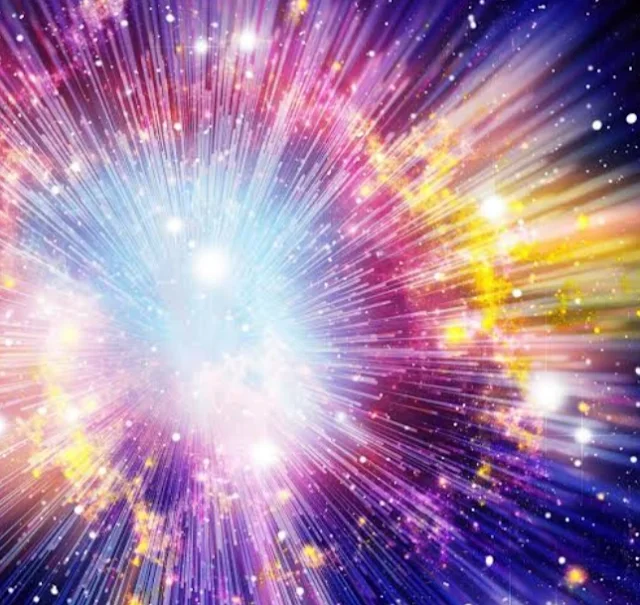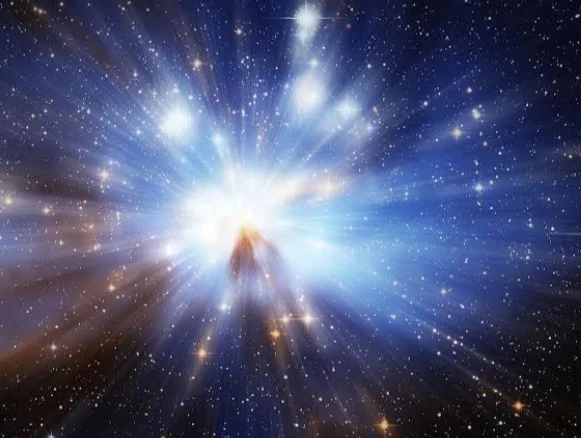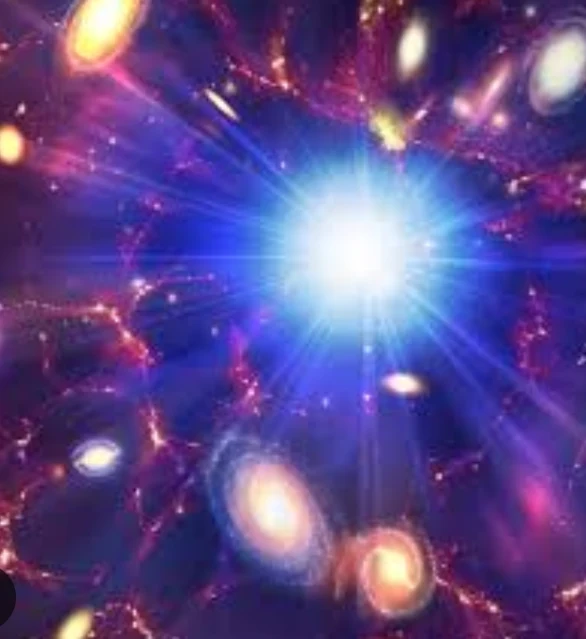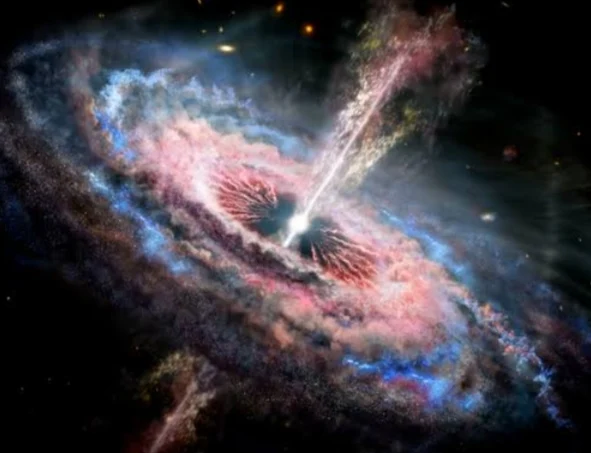The Big Bang Theory: A Scientific Explanation of the Universe's Origin
The Big Bang theory is the prevailing scientific model for the origin and evolution of the universe. It proposes that the universe began in a very hot, dense state and has been expanding and cooling ever since.
This theory is not simply a guess, but a well-supported explanation backed by extensive evidence and observations gathered through various scientific disciplines.
Key Points of the Big Bang Theory:
- Initial State: The universe began in a state of incredibly high density and temperature, estimated to be smaller than an atom and unimaginably hot.
- Expansion and Cooling: Since its inception, the universe has been continuously expanding and cooling. This expansion is still ongoing, evidenced by the redshift of distant galaxies.
- Formation of Matter: As the universe cooled, subatomic particles like protons and neutrons formed, followed by the first atoms (mainly hydrogen and helium) through a process called Big Bang nucleosynthesis.
- Evolution of Structure: Over time, gravity caused denser regions in the early universe to collapse, forming stars, galaxies, and eventually the large-scale structures we observe today.
Evidence Supporting the Big Bang Theory:
- Cosmic Microwave Background (CMB): This faint afterglow radiation permeates the universe and is considered the "fossil light" of the Big Bang. Its properties align with predictions based on the theory's timeline and early conditions.
- Redshift of Galaxies: Most distant galaxies exhibit a redshift, indicating their movement away from us and supporting the universe's ongoing expansion.
- Abundance of Light Elements: The observed abundance of light elements like hydrogen and helium throughout the universe matches the predictions of Big Bang nucleosynthesis.
- Large-Scale Structure of the Universe: The distribution of galaxies and galaxy clusters aligns with the predicted evolution of density fluctuations in the early universe.
Strengths of the Big Bang Theory:
- Explains a wide range of observations: The theory provides a comprehensive framework that explains various cosmological phenomena, from the abundance of light elements to the large-scale structures of the universe.
- Predictive power: The theory's predictions, based on its underlying physics, have consistently matched subsequent scientific observations and discoveries, strengthening its credibility.
- Evolving with new discoveries: While the core principles remain robust, the Big Bang theory is not static. It incorporates new discoveries and ongoing research, such as the exploration of dark matter and dark energy, to refine our understanding of the universe's evolution.
Limitations and Ongoing Research:
Despite its success, the Big Bang theory still faces some unanswered questions and limitations. These include:
- The nature of the singularity: The theory suggests a point of infinite density and temperature at the universe's origin, which is beyond our current physical understanding.
- The role of dark matter and dark energy: These mysterious components are thought to comprise most of the universe's energy and matter, but their nature and behavior remain largely unknown.
Ongoing research in these areas, alongside advancements in technology and observation capabilities, will further refine our understanding of the Big Bang theory and the universe's origin and evolution.
The Big Bang theory is the prevailing scientific model for the origin and evolution of the universe. It proposes that the universe began in a very hot, dense state and has been expanding and cooling ever since.
This theory is not simply a guess, but a well-supported explanation backed by extensive evidence and observations gathered through various scientific disciplines.
Key Points of the Big Bang Theory:
- Initial State: The universe began in a state of incredibly high density and temperature, estimated to be smaller than an atom and unimaginably hot.
- Expansion and Cooling: Since its inception, the universe has been continuously expanding and cooling. This expansion is still ongoing, evidenced by the redshift of distant galaxies.
- Formation of Matter: As the universe cooled, subatomic particles like protons and neutrons formed, followed by the first atoms (mainly hydrogen and helium) through a process called Big Bang nucleosynthesis.
- Evolution of Structure: Over time, gravity caused denser regions in the early universe to collapse, forming stars, galaxies, and eventually the large-scale structures we observe today.
Evidence Supporting the Big Bang Theory:
- Cosmic Microwave Background (CMB): This faint afterglow radiation permeates the universe and is considered the "fossil light" of the Big Bang. Its properties align with predictions based on the theory's timeline and early conditions.
- Redshift of Galaxies: Most distant galaxies exhibit a redshift, indicating their movement away from us and supporting the universe's ongoing expansion.
- Abundance of Light Elements: The observed abundance of light elements like hydrogen and helium throughout the universe matches the predictions of Big Bang nucleosynthesis.
- Large-Scale Structure of the Universe: The distribution of galaxies and galaxy clusters aligns with the predicted evolution of density fluctuations in the early universe.
Strengths of the Big Bang Theory:
- Explains a wide range of observations: The theory provides a comprehensive framework that explains various cosmological phenomena, from the abundance of light elements to the large-scale structures of the universe.
- Predictive power: The theory's predictions, based on its underlying physics, have consistently matched subsequent scientific observations and discoveries, strengthening its credibility.
- Evolving with new discoveries: While the core principles remain robust, the Big Bang theory is not static. It incorporates new discoveries and ongoing research, such as the exploration of dark matter and dark energy, to refine our understanding of the universe's evolution.
Limitations and Ongoing Research:
Despite its success, the Big Bang theory still faces some unanswered questions and limitations. These include:
- The nature of the singularity: The theory suggests a point of infinite density and temperature at the universe's origin, which is beyond our current physical understanding.
- The role of dark matter and dark energy: These mysterious components are thought to comprise most of the universe's energy and matter, but their nature and behavior remain largely unknown.
Ongoing research in these areas, alongside advancements in technology and observation capabilities, will further refine our understanding of the Big Bang theory and the universe's origin and evolution.
The Big Bang Theory: Unveiling the Evidence
This rephrased title clarifies the focus on evidence supporting the Big Bang theory, which aligns better with the scientific process. While "prove" can be used colloquially, it's important to be mindful of its limitations in scientific discourse.
Here are some key pieces of evidence supporting the Big Bang theory:
- Cosmic Microwave Background (CMB): This faint afterglow of the Big Bang permeates the entire universe, providing strong support for a hot, dense origin.
- Redshift of Galaxies: Most galaxies are moving away from us, suggesting the universe is expanding, as predicted by the Big Bang.
- Abundance of Light Elements: The observed abundance of light elements like hydrogen and helium closely matches the predictions of Big Bang nucleosynthesis.
- Large Scale Structure: The large-scale structure of the universe, with its clusters and voids of galaxies, can be explained by the evolution of density fluctuations predicted by the Big Bang.
These are just some of the numerous pieces of evidence that collectively form a strong case for the Big Bang as the prevailing theory of our universe's origin. While science is always open to new discoveries and the possibility of revision, the Big Bang theory currently holds the most robust explanation for the observed universe based on extensive and multifaceted evidence.
The Big Bang Theory: Research and Exploration
The Big Bang theory, the prevailing cosmological model, proposes the universe began as an incredibly hot, dense state and has been expanding and cooling ever since. This theory rests on a foundation of extensive research and exploration across various scientific disciplines.
Key areas of research supporting the Big Bang theory include:
-
Cosmic Microwave Background (CMB): This faint afterglow, the oldest light observable, fills the universe. The CMB's uniformity and temperature fluctuations closely match the Big Bang's predictions.
-
Redshift of Galaxies: Most distant galaxies exhibit a redshift, their light shifting towards the red end of the spectrum as they recede from us. This phenomenon aligns with the universe's expansion, as predicted by the Big Bang.
-
Abundance of Light Elements: The Big Bang theory explains the observed abundance of light elements like hydrogen and helium through Big Bang nucleosynthesis, accurately predicting their observed ratios.
-
Large-Scale Structure of the Universe: The large-scale distribution of galaxies and clusters exhibits a specific structure explained by the evolution of density fluctuations in the early universe, as predicted by the Big Bang.
Ongoing research and exploration continue to refine our understanding:
-
Advanced Telescopes: Instruments like the Hubble Space Telescope and upcoming missions like the James Webb Space Telescope allow us to observe further back in time, providing insights into the Big Bang's early stages.
-
Gravitational Wave Astronomy: Detecting gravitational waves from collisions of massive objects like black holes offers new opportunities to study the universe's early stages and test aspects of the Big Bang theory.
-
Dark Matter and Dark Energy: The vast majority of the universe's energy and matter is thought to be in the form of dark matter and dark energy, which remain poorly understood. Research into these remains crucial for a complete picture of the universe's origin and evolution.
The Big Bang theory remains the most comprehensive and successful explanation for the universe's origin and evolution. Continued research promises to further refine our understanding of this grand story and answer the remaining mysteries about our cosmic origins.
The Big Bang Theory: A Scientific Perspective
The Big Bang theory is the prevailing scientific model for the origin and evolution of the universe. It postulates that the universe began in a very hot, dense state and has been expanding and cooling ever since. This theory is not simply a hypothesis, but a well-supported explanation backed by extensive evidence and observations.
Key Scientific Evidence Supporting the Big Bang:
-
Cosmic Microwave Background (CMB): This faint afterglow radiation permeates the universe and is considered the "fossil light" of the Big Bang. The CMB's properties, such as its uniformity and temperature fluctuations, precisely match predictions based on the Big Bang's timeline and early conditions.
-
Redshift of Galaxies: Most distant galaxies exhibit a redshift, meaning their light is shifted towards the red end of the spectrum as they move away from us. This phenomenon, known as Doppler shift, aligns perfectly with the universe's ongoing expansion, a core tenet of the Big Bang theory.
-
Abundance of Light Elements: The Big Bang theory explains the observed abundance of light elements like hydrogen and helium in the universe through a process called Big Bang nucleosynthesis. This process accurately predicts the observed ratios of these elements, which wouldn't be possible under any other known cosmological model.
-
Large-Scale Structure of the Universe: The distribution of galaxies and galaxy clusters across the vast universe exhibits a specific, large-scale structure. This structure can be explained by the evolution of density fluctuations in the early universe, as predicted by the Big Bang model.
Strengths of the Big Bang Theory:
-
Explains a wide range of observations: The Big Bang offers a comprehensive framework that explains various cosmological phenomena, from the abundance of light elements to the large-scale structures of the universe.
-
Predictions match observations: The theory's predictions, based on its underlying physics, have consistently matched subsequent scientific observations and discoveries, strengthening its credibility.
-
Evolving with new discoveries: While the core principles remain robust, the Big Bang theory is not static. It incorporates new discoveries and ongoing research, such as the exploration of dark matter and dark energy, to refine our understanding of the universe's evolution.
Limitations and Ongoing Research:
Despite its success, the Big Bang theory still faces some unanswered questions and limitations. These include:
-
The nature of the singularity: The theory suggests a point of infinite density and temperature at the universe's origin, which is currently beyond the reach of our current physical understanding.
-
The role of dark matter and dark energy: These mysterious components are thought to comprise most of the universe's energy and matter, but their nature and behavior remain largely unknown. Further research in these areas is crucial for a more complete picture of the universe's origin and evolution.
The Big Bang theory, based on extensive scientific evidence and supported by numerous observations, remains the most comprehensive and successful model for understanding the universe's origin and evolution. It continues to guide scientific exploration and provides a framework for understanding our place within the vast cosmos.




